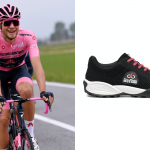
The technological evolution of bike shorts
The item that has rewriten the rules of sportswear: from the races to the catwalks
March 12th, 2019
We have already talked about how clothing and cycling accessories have been rediscovered as fashion items: products sold today are the result of a technical and sports evolution that led to cycling to a revolution of materials and components used during the competitions, which we find on the catwalks of the whole world.
One of the products that have regained the most attention is the bike shorts, presented in different collections and worn by Kim Kardashian in every possible combination. If many were amazed, this item was very fashionable in the 90s: we talked about it here.
Yet the stylistic aspect, although surprising, is not comparable to the effect that this garment has had within the races. We often look at lighter frames, the integration of scientific research that improves the athlete's position on the bike to the limit. You end up ignoring too often a product that is visually and technically it may seem not so innovative but, acting in the shadow like the work of a gregarious for the captain, has revolutionized cycling: the shorts worn by athletes, becoming their second skin.
To understand the effects that it has had in the evolution of this sport, let's retrace the story.

BLACK AND WOOL
The first running shorts were made by black wool: a material that was always warm and a color that masked the fact that they were placed on oiled saddles for several hours. Despite the improvements in leather upholstery, the garments worn were far from what is worn today.

LYCRA AND COLOR
The first big revolution came in 1976 when in one night, all the wool shorts became obsolete: the Swiss brand Assos presents the first model in Lycra, built for the Ti-Raleigh team. The new material was invented by the American DuPont as early as 1959 and until then was used in skiing and swimming: the intuition to bring it in cycling will change the comfort of athletes forever. A light, soft, flexible and above all extendable yarn: this allowed shorts to adapt perfectly to the muscles, following the tension during each pedal stroke. If the Swiss company has had the credit of having introduced it in cycling, it is the genius of Maurizio Castelli who brought it to the public: since 1977 the Italian company introduces among its products an aerodynamic model that maintained the same graphic characteristics of those of wool, black with the white mark. The amateurs immediately created queues outside the factory to buy the new models, a sign of how the shorts were a fundamental element for cyclists and had remained too obsolete.
The design changed quickly: straps to support the trousers were integrated into a single piece, but the detail that caught the eye in the 1981 Giro d'Italia was the introduction of colored shorts. Believe it or not, at that time there was a rule that forced the teams to wear only black shorts: Maurizio Castelli put on the first colored shorts to the Bottecchia-Honved athletes who, on the starting line, brought new turquoise trousers. There are no images in the running of colored shorts because they were obliged to replace them: nevertheless, for the company, there was a great return of image and, the real revolution, would arrive soon.
The Italian company is, in fact, a pioneer in sublimation printing: an innovative method that allows printing images with high quality, without color limits and above all without the athlete feeling the effect and weight that were previously given by the seams of patches on clothing. If you think that, in a side view, the cyclist's leg occupies most of his visible portion of the body: with the ability to print colorful writing shorts have become advertising spaces, opening up to modern cycling. The teams can print logos of sponsors that support them, having visibility in the race. Even today, especially for smaller teams, these spaces are essential to build the budget that makes the team operational throughout the season. Shorts had reached a high level in a few years, passing through large revolutions that had in a short time improved its appearance. With development and research, mutation and evolution has never stopped and although not very visible has brought clear improvements in athletes.
Especially in the part of the pad, in contact with the seat, which creates more problems in athletes and can change the performance.
THE LATEST GREAT INNOVATIONS
In 1998 Castelli launches the first anatomic pad that fits the body of the cyclist. A further evolution came from Assos, which brought to the market the backstop that is now used by all professionals, marking the future: produced with Cytech, the first elastic pad reduces skin rubbing and perfectly follows the movement of the body.
Alternately, the two houses offer innovations on the market: in 2009 Castelli Cycling returns to the spotlight that in 2007 introduces an elastic band at the end of the shorts, fixing them to the quadriceps of athletes just above the knee and minimizing the air intake under the fabric. Legs remain so hermetically warm allowing better performance in all conditions. Two years later, the most revolutionary model of the last decade arrives on the market: Body Paint makes its debut on the market. It is a shorts made with a single piece of fabric and with multiple integrated components without seams. Today shorts are a second light layer, which adapts perfectly to rider's legs without hindering its movement. The compression of muscles is treated in detail: the heat-sealed pieces are made by different materials to allow the athlete to release all the watts he has in his legs without any impediment.
NOT LIKE THE OTHER CLOTHES
Legs are the engine of a cyclist, and shorts that cover them can be seen by everyone: over the years has become an increasingly fundamental object for the athlete and, without neglecting the appearance, he returned to the catwalks as a fashion designer.
Already in 1995 Lady Diana anticipates the trend by wearing them as a sports garment but, as already mentioned, it is nowadays that have risen to present themselves to fashion shows thanks to Kim Kardashian, Bella Hadid and Hailey Baldwin. But if you expect to see him branded by sporting brands like Fila, you're wrong: Fendi brought him on the catwalk, marveling at the audience who considered him an anti-fashion boss and, above all, not very feminine. And it is in this elevation that cycling shorts get a little justice from the female universe because men focus almost exclusively on other details to improve their sporting performance, taking for granted a garment that, as we have seen, has revolutionized cycling.



















